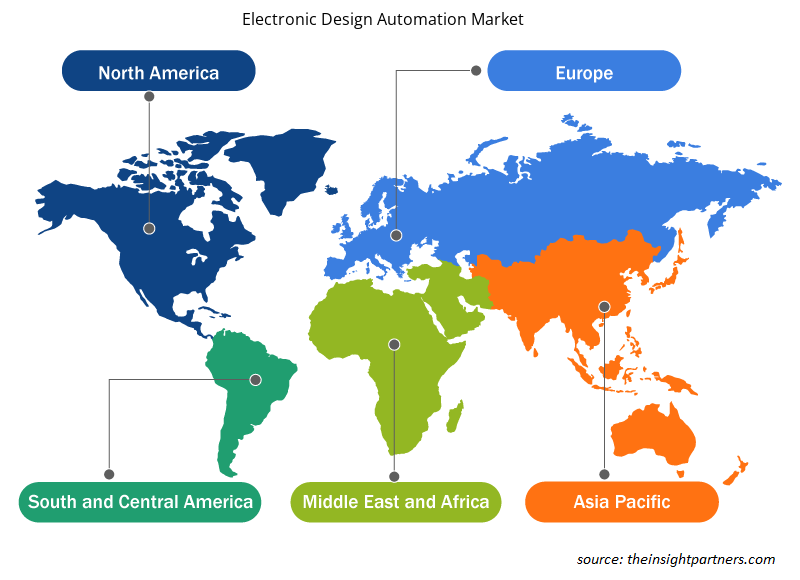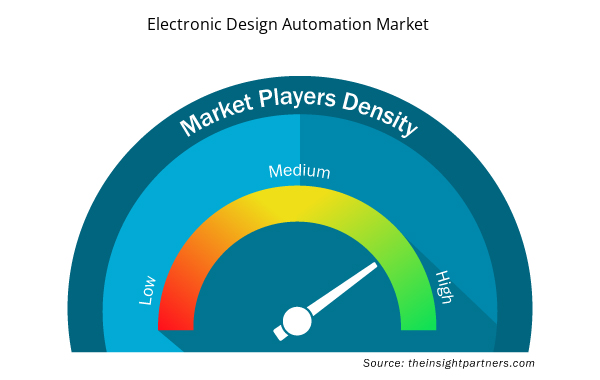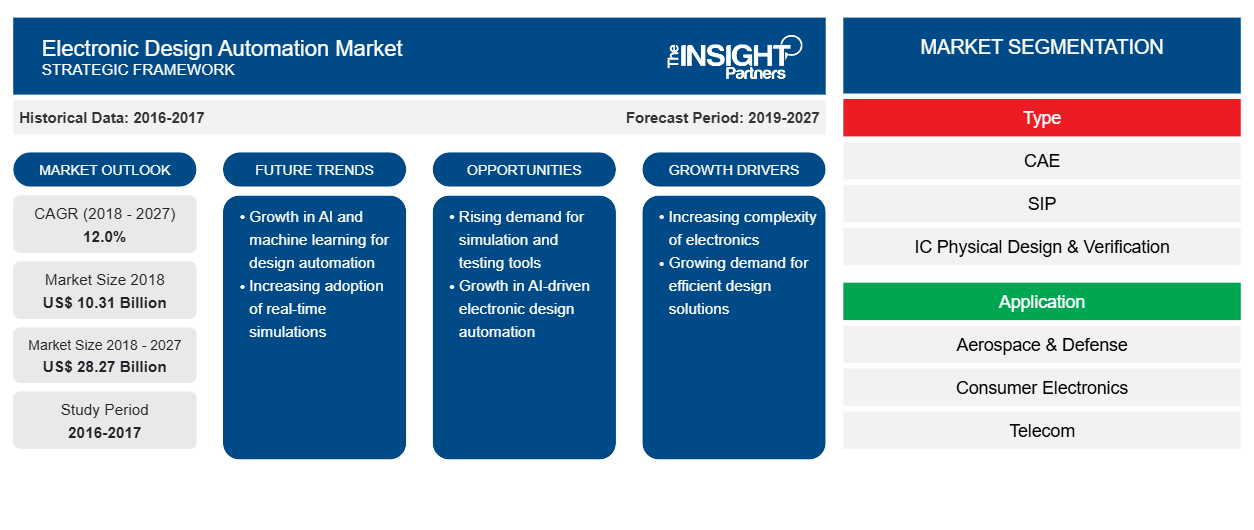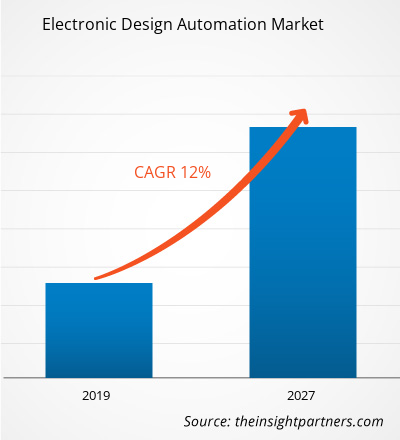Il mercato dell'automazione della progettazione elettronica ha rappresentato 10,31 miliardi di dollari nel 2018 e si prevede che crescerà a un CAGR del 12,0% nel periodo di previsione 2019-2027, fino a raggiungere i 28,27 miliardi di dollari entro il 2027.
Il software di automazione della progettazione elettronica comprende più strumenti e applicazioni. Integrare questi strumenti in base alla domanda dei clienti a volte diventa un lavoro complicato. I requisiti complessi degli utenti finali in merito al posizionamento del prodotto altamente stabile e accurato vengono affrontati con l'aiuto di EDA. Le crescenti complessità e le sfide in termini di costi affrontate dalle industrie per l'implementazione di costosi progetti complessi sono fattori chiave che guidano la domanda di EDA.
Si prevede che l'APAC sarà la regione dominante nel mercato dell'automazione della progettazione elettronica. La ragione principale di ciò è l'enorme hub di elettronica e semiconduttori in Cina, unito all'elevata densità di popolazione della regione. Inoltre, la Cina rappresenta le maggiori spedizioni di semiconduttori in tutto il mondo, si prevede che le nuove iniziative di mercato e le partnership strategiche continueranno durante il periodo di previsione, contribuendo all'elevata crescita del mercato dell'automazione della progettazione elettronica nella regione.
Personalizza questo report in base alle tue esigenze
Riceverai la personalizzazione gratuita di qualsiasi report, comprese parti di questo report, o analisi a livello nazionale, pacchetto dati Excel, oltre a usufruire di grandi offerte e sconti per start-up e università
- Scopri le principali tendenze di mercato in questo rapporto.Questo campione GRATUITO includerà analisi di dati che spaziano dalle tendenze di mercato alle stime e alle previsioni.
Crescita dell'industria dei semiconduttori
La SIA (Semiconductor Industry Association) nell'ottobre 2018, pur rappresentando la leadership statunitense nella ricerca, progettazione e produzione di semiconduttori, ha registrato un aumento del 12,7% rispetto al 2017 e ha segnato un fatturato totale di 41,8 miliardi di dollari. Inoltre, il WSTS ha anche previsto una traiettoria del 15,9% nel 2018 e del 2,6% nel 2019. Questa crescita nel settore dei semiconduttori ha aumentato la fiducia degli operatori del mercato dell'automazione della progettazione elettronica in termini di crescita del fatturato. Le aziende che operano nel panorama dei semiconduttori non solo prevedono un aumento sostanziale del fatturato, ma stanno anche rispettivamente aumentando la loro spesa in R&S. L'aumento anno su anno della spesa in R&S ha imposto una spinta notevole al mercato dell'automazione della progettazione elettronica nel recente passato e si prevede che continuerà a guidare il mercato negli anni a venire.
Poiché l'industria dei semiconduttori continua a essere in forte fase di crescita, si prevede che i leader del mercato dell'automazione della progettazione elettronica adotteranno un approccio orientato al futuro prendendo in considerazione mercati finali non convenzionali come l'intelligenza artificiale, i veicoli autonomi e l'IoT. Inoltre, è probabile che le aziende di memoria assistano anche a un aumento delle vendite dovuto al rafforzamento della domanda di data center, smartphone e tecnologie per veicoli autonomi. La convergenza di innumerevoli mercati di utenti finali di semiconduttori ha portato a una significativa espansione del settore, che in risposta ha guidato il mercato dell'automazione della progettazione elettronica per tecnologia, software e automazione.
Crescente penetrazione di IoT, intelligenza artificiale e realtà virtuale
Case intelligenti, TV, smartphone, Internet delle cose, auto connesse, intelligenza artificiale sono tutti gli aspetti della vita umana che l'industria dell'elettronica di consumo ha pervaso. La domanda di elettronica di consumo in tutto il mondo è stata ampiamente guidata dal desiderio dei consumatori di capacità più grandi, più nuove e migliorate, che a sua volta ha incoraggiato il settore a esplorare costantemente innovazioni e tecnologie che non solo racchiudono l'immaginazione delle persone, ma sono anche accessibili e pertinenti in termini di soddisfazione delle loro esigenze quotidiane. In tali casi, i fornitori di software EDA, i produttori di componenti elettronici e i tecnologi progettano prototipi adatti dei dispositivi. Pertanto, si prevede che l'evoluzione delle aspettative dei consumatori e la crescente domanda di elettronica di consumo guideranno il mercato EDA nei prossimi anni.
Di seguito sono elencate alcune delle strategie recenti di alcuni degli attori del mercato dell'automazione della progettazione elettronica:
2018: Cadence Design Systems, Inc. ha annunciato una partnership strategica con Green Hills Software per accelerare la sicurezza e la protezione integrate. Cadence Design Systems, Inc. ha investito 150 milioni di $, ovvero circa il 16% di partecipazione in GreenHill.
2018: Keysight Technologies è stata selezionata da ON Semiconductor come partner EDA per la fornitura di una soluzione di progettazione per dispositivi di potenza che dovrebbe aumentare l'affidabilità e accelerare il time-to-market.
2018: Synopsys, Inc. e Siemens AG hanno annunciato una collaborazione per un'ampia gamma di progetti EDA. Inoltre, Siemens e Synopsys hanno risolto tutte le controversie sui brevetti in sospeso tra Synopsys e Mentor Graphics.
Il rapporto segmenta il mercato globale dell'automazione della progettazione elettronica come segue:
Approfondimenti regionali sul mercato dell'automazione della progettazione elettronica
Le tendenze regionali e i fattori che influenzano il mercato dell'automazione della progettazione elettronica durante il periodo di previsione sono stati ampiamente spiegati dagli analisti di Insight Partners. Questa sezione discute anche i segmenti e la geografia del mercato dell'automazione della progettazione elettronica in Nord America, Europa, Asia Pacifico, Medio Oriente e Africa e America centrale e meridionale.

- Ottieni i dati specifici regionali per il mercato dell'automazione della progettazione elettronica
Ambito del rapporto di mercato sull'automazione della progettazione elettronica
| Attributo del report | Dettagli |
|---|---|
| Dimensioni del mercato nel 2018 | 10,31 miliardi di dollari USA |
| Dimensioni del mercato entro il 2027 | 28,27 miliardi di dollari USA |
| CAGR globale (2018 - 2027) | 12,0% |
| Dati storici | 2016-2017 |
| Periodo di previsione | 2019-2027 |
| Segmenti coperti | Per tipo
|
| Regioni e Paesi coperti | America del Nord
|
| Leader di mercato e profili aziendali chiave |
|
Densità degli attori del mercato dell'automazione della progettazione elettronica: comprendere il suo impatto sulle dinamiche aziendali
Il mercato dell'Electronic Design Automation Market sta crescendo rapidamente, spinto dalla crescente domanda degli utenti finali dovuta a fattori quali l'evoluzione delle preferenze dei consumatori, i progressi tecnologici e una maggiore consapevolezza dei vantaggi del prodotto. Con l'aumento della domanda, le aziende stanno ampliando le loro offerte, innovando per soddisfare le esigenze dei consumatori e capitalizzando sulle tendenze emergenti, il che alimenta ulteriormente la crescita del mercato.
La densità degli operatori di mercato si riferisce alla distribuzione di aziende o società che operano in un particolare mercato o settore. Indica quanti concorrenti (operatori di mercato) sono presenti in un dato spazio di mercato in relazione alle sue dimensioni o al valore di mercato totale.
Le principali aziende che operano nel mercato dell'automazione della progettazione elettronica sono:
- Società anonima
- Aldec, Inc.
- Autodesk, Inc.
- Sistemi di progettazione Cadence, Inc.
- Laboratorio di elettronica Labcenter Ltd.
Disclaimer : le aziende elencate sopra non sono classificate secondo un ordine particolare.

- Ottieni una panoramica dei principali attori del mercato dell'automazione della progettazione elettronica
Mercato globale dell'automazione della progettazione elettronica - Per tipo
- Ingegneria assistita da computer (CAE)
- Proprietà intellettuale dei semiconduttori (SIP)
- Progettazione fisica e verifica dei circuiti integrati
- Circuito stampato (PCB) e modulo multi-chip (MCM)
Mercato globale dell'automazione della progettazione elettronica - Per applicazione
- Aerospaziale e difesa
- Elettronica di consumo
- Telecom
- Automobilistico
- Industriale
- Altri
Mercato globale dell'automazione della progettazione elettronica - Per area geografica
- America del Nord
- NOI
- Canada
- Messico
- Europa
- Francia
- Germania
- Italia
- Spagna
- Regno Unito
- Resto d'Europa
- Asia Pacifico (APAC)
- Cina
- India
- Giappone
- Corea del Sud
- Resto dell'APAC
- Resto del mondo (RoW)
- Sud America
- Medio Oriente e Africa
Mercato globale dell'automazione della progettazione elettronica - Profili aziendali
- Società anonima
- Aldec, Inc.
- Autodesk, Inc.
- Sistemi di progettazione Cadence, Inc.
- Laboratorio di elettronica Labcenter Ltd.
- Tecnologie Keysight
- Società di grafica Mentor
- Silvaco, Inc.
- Società anonima
- Società a responsabilità limitata
- Analisi storica (2 anni), anno base, previsione (7 anni) con CAGR
- Analisi PEST e SWOT
- Valore/volume delle dimensioni del mercato - Globale, regionale, nazionale
- Industria e panorama competitivo
- Set di dati Excel


- Single Pair Ethernet Market
- Mesotherapy Market
- Skin Tightening Market
- Medical Devices Market
- Ceiling Fans Market
- Point of Care Diagnostics Market
- Excimer & Femtosecond Ophthalmic Lasers Market
- Health Economics and Outcome Research (HEOR) Services Market
- Collagen Peptides Market
- Europe Industrial Chillers Market

Report Coverage
Revenue forecast, Company Analysis, Industry landscape, Growth factors, and Trends

Segment Covered
This text is related
to segments covered.

Regional Scope
North America, Europe, Asia Pacific, Middle East & Africa, South & Central America

Country Scope
This text is related
to country scope.
Trends and growth analysis reports related to Technology, Media and Telecommunications : READ MORE..
The List of Companies
- Agnisys Inc.
- Aldec, Inc.
- Autodesk, Inc.
- Cadence Design Systems, Inc.
- Labcenter Electronics Ltd.
- Keysight Technologies
- Mentor Graphics Corporation
- Silvaco, Inc.
- Synopsys, Inc.
- Zuken Inc.
The Insight Partners performs research in 4 major stages: Data Collection & Secondary Research, Primary Research, Data Analysis and Data Triangulation & Final Review.
- Data Collection and Secondary Research:
As a market research and consulting firm operating from a decade, we have published and advised several client across the globe. First step for any study will start with an assessment of currently available data and insights from existing reports. Further, historical and current market information is collected from Investor Presentations, Annual Reports, SEC Filings, etc., and other information related to company’s performance and market positioning are gathered from Paid Databases (Factiva, Hoovers, and Reuters) and various other publications available in public domain.
Several associations trade associates, technical forums, institutes, societies and organization are accessed to gain technical as well as market related insights through their publications such as research papers, blogs and press releases related to the studies are referred to get cues about the market. Further, white papers, journals, magazines, and other news articles published in last 3 years are scrutinized and analyzed to understand the current market trends.
- Primary Research:
The primarily interview analysis comprise of data obtained from industry participants interview and answers to survey questions gathered by in-house primary team.
For primary research, interviews are conducted with industry experts/CEOs/Marketing Managers/VPs/Subject Matter Experts from both demand and supply side to get a 360-degree view of the market. The primary team conducts several interviews based on the complexity of the markets to understand the various market trends and dynamics which makes research more credible and precise.
A typical research interview fulfils the following functions:
- Provides first-hand information on the market size, market trends, growth trends, competitive landscape, and outlook
- Validates and strengthens in-house secondary research findings
- Develops the analysis team’s expertise and market understanding
Primary research involves email interactions and telephone interviews for each market, category, segment, and sub-segment across geographies. The participants who typically take part in such a process include, but are not limited to:
- Industry participants: VPs, business development managers, market intelligence managers and national sales managers
- Outside experts: Valuation experts, research analysts and key opinion leaders specializing in the electronics and semiconductor industry.
Below is the breakup of our primary respondents by company, designation, and region:

Once we receive the confirmation from primary research sources or primary respondents, we finalize the base year market estimation and forecast the data as per the macroeconomic and microeconomic factors assessed during data collection.
- Data Analysis:
Once data is validated through both secondary as well as primary respondents, we finalize the market estimations by hypothesis formulation and factor analysis at regional and country level.
- Macro-Economic Factor Analysis:
We analyse macroeconomic indicators such the gross domestic product (GDP), increase in the demand for goods and services across industries, technological advancement, regional economic growth, governmental policies, the influence of COVID-19, PEST analysis, and other aspects. This analysis aids in setting benchmarks for various nations/regions and approximating market splits. Additionally, the general trend of the aforementioned components aid in determining the market's development possibilities.
- Country Level Data:
Various factors that are especially aligned to the country are taken into account to determine the market size for a certain area and country, including the presence of vendors, such as headquarters and offices, the country's GDP, demand patterns, and industry growth. To comprehend the market dynamics for the nation, a number of growth variables, inhibitors, application areas, and current market trends are researched. The aforementioned elements aid in determining the country's overall market's growth potential.
- Company Profile:
The “Table of Contents” is formulated by listing and analyzing more than 25 - 30 companies operating in the market ecosystem across geographies. However, we profile only 10 companies as a standard practice in our syndicate reports. These 10 companies comprise leading, emerging, and regional players. Nonetheless, our analysis is not restricted to the 10 listed companies, we also analyze other companies present in the market to develop a holistic view and understand the prevailing trends. The “Company Profiles” section in the report covers key facts, business description, products & services, financial information, SWOT analysis, and key developments. The financial information presented is extracted from the annual reports and official documents of the publicly listed companies. Upon collecting the information for the sections of respective companies, we verify them via various primary sources and then compile the data in respective company profiles. The company level information helps us in deriving the base number as well as in forecasting the market size.
- Developing Base Number:
Aggregation of sales statistics (2020-2022) and macro-economic factor, and other secondary and primary research insights are utilized to arrive at base number and related market shares for 2022. The data gaps are identified in this step and relevant market data is analyzed, collected from paid primary interviews or databases. On finalizing the base year market size, forecasts are developed on the basis of macro-economic, industry and market growth factors and company level analysis.
- Data Triangulation and Final Review:
The market findings and base year market size calculations are validated from supply as well as demand side. Demand side validations are based on macro-economic factor analysis and benchmarks for respective regions and countries. In case of supply side validations, revenues of major companies are estimated (in case not available) based on industry benchmark, approximate number of employees, product portfolio, and primary interviews revenues are gathered. Further revenue from target product/service segment is assessed to avoid overshooting of market statistics. In case of heavy deviations between supply and demand side values, all thes steps are repeated to achieve synchronization.
We follow an iterative model, wherein we share our research findings with Subject Matter Experts (SME’s) and Key Opinion Leaders (KOLs) until consensus view of the market is not formulated – this model negates any drastic deviation in the opinions of experts. Only validated and universally acceptable research findings are quoted in our reports.
We have important check points that we use to validate our research findings – which we call – data triangulation, where we validate the information, we generate from secondary sources with primary interviews and then we re-validate with our internal data bases and Subject matter experts. This comprehensive model enables us to deliver high quality, reliable data in shortest possible time.


 Ottieni un campione gratuito per questo repot
Ottieni un campione gratuito per questo repot